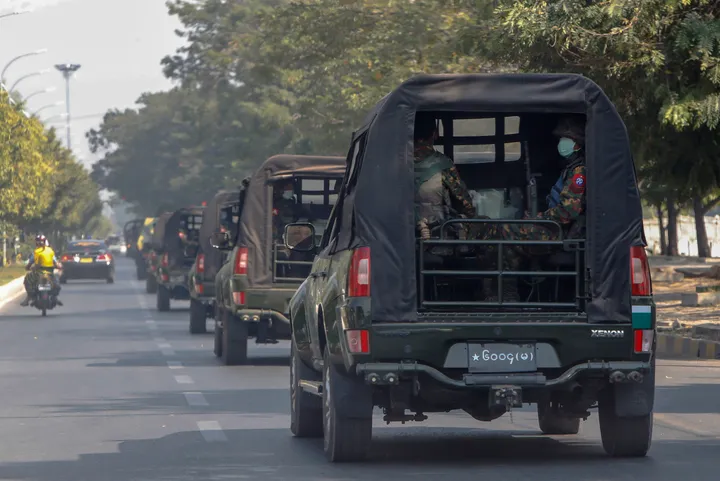Iran’s move to produce drones for Tajikistan, a Central Asian state having strong cultural and ethnic connections with Tehran, marks a crucial milestone for the Shia-majority country.
While Iran produces drones for its national defence, its drone factory in Tajikistan will be its first offshore arms production facility.
“This is the first time that Iran has started mass production of military equipment abroad. This is the first time that the Islamic Republic is transferring production line know-how by officially inaugurating a manufacturing factory in Tajikistan,” says Hosein Dalirian, a Tehran-based Iranian journalist. Iran’s drones, named Ababil-2, will be multi-role tactical unmanned aerial vehicles, he says.
The inauguration of the drone factory on Tuesday is proof that Iran is seeking to reinforce its friendly relations across the region, empowering its allies and securing their interests alongside its own interests, according to Dalirian. “Certainly, Tajikistan is a brotherly and friendly country to Iran,” Dalirian tells TRT World.
According to Iran’s official IRNA news agency, Gen. Mohammad Hossein Bagheri, the head of Iran’s armed forces, was in Tajikistan during the official ceremony for the drone factory’s inauguration.
“We are in a position to, apart from meeting our domestic need, export military equipment to allied and friendly countries to help increase security and sustainable peace,” Bagheri said at the opening ceremony.
Ulas Pehlivan, a security analyst and a former Turkish military officer, sees other political motives in the two neighbouring countries’ military cooperation. “Enduring US sanctions force Iran to enlarge its own sphere of influence in the region,” Pehlivan tells TRT World.
Overlapping interests
Tajikistan and Iran have many commonalities. Their populations largely speak the Persian language and both states are wary of the Taliban rule in Afghanistan for their own reasons. In recent years, Iran and Tajikistan, which gained independence following the collapse of the Soviet Union in 1991, have gotten closer, particularly due to the turbulent Afghan politics.
Unlike the Sunni-dominated Taliban, Iran is a Shia-majority country and is angry about attacks on Afghanistan's Shia minority, Hazaras. On the other hand, Tajikistan has a secular rule, which is a stark difference to the Taliban's religious-minded governance.
Like Iran, Tajikistan also has a lot of concerns about the Pashtun-dominated Taliban rule in a country where the Tajiks are the second biggest ethnicity. Iran has also long backed Afghanistan’s Tajiks to create an "eastern Iranian arc", which would also include Tajikistan itself, according to Kirill Semenov, a Russian expert.
“Iran sees Tajikistan not only as a springboard to further its military, political and economic interests in Central Asia but also as an opportunity to demonstrate its cultural and ‘spiritual’ potential,” Semenov wrote.
Tajikistan also needs Iran for various reasons.
“Dushanbe needs to improve its defence capabilities against possible threats from Afghanistan. Also Tajikistan needs to secure its border with both Afghanistan and Kyrgyzstan where clashes and illegal crossings continue,” says Pehlivan, referring to why Tajikistan needs Iranian drones.
But there is more to Dushanbe’s rapprochement with Tehran. “Landlocked Tajikistan’s international trade also needs to have access to the high seas through Iran. And Iran seeks to overcome its Saudi competitors in Tajikistan,” Pehlivan says.
“Iran and Tajikistan are seeking to promote and develop joint defence and military cooperation and this will certainly strengthen Dushanbe in the arms sphere given Iran’s advanced military capabilities,” says Dalirian, the Iranian journalist. The Tajik president previously confirmed the country’s plans to strengthen ties with Iran, the journalist adds.
Are Iranian drones up to the job?
While Dalirian believes Iranian drone technology is developing rapidly, Pehlivan is not sure that Tehran’s drones have reached a level Turkish drones currently enjoy in a proven efficiency across different battlefields from Azerbaijan’s Karabakh, a disputed region between Yerevan and Baku, to Libya’s capital Tripoli.
Iran’s move to open a drone manufacturing factory in Tajikistan “highlights the fact that Iran’s drone technology has reached a point that it is now able to transfer its know-how to other countries”, according to Dalirian.
“Iranian military experts in recent years have managed to develop indigenous arms manufacturing capabilities in various areas despite the sanctions imposed by the US and the West,” Dalirian adds.
Under heavy US sanctions, Iran has no other way than relying on itself to improve its own capacity on drones. “Even though Iranian drone technology is rather limited, Tehran continues its UAV development efforts by transferring its experience on rocket/missile technologies to the UAV field,” Pehlivan says.
There are signs that Iran receives support from China and Russia, the two anti-Western countries like Tehran, to develop its defence technology, according to Pehlivan. “However, they could not so far manage to manufacture drones that have proven themselves on the battlefield, such as Türkiye’s Bayraktar, Karayel and Anka."
The success stories of Turkey’s Bayraktars in Azerbaijan’s Karabakh and sales to Turkic Central Asian states and Tajikistan, a non-Turkic central Asia nation, might also have pushed Iran to open its first military production line abroad, Pehlivan views.
“Iran having cultural, geographical and historical proximity with Tajikistan could also seek to compete with Türkiye’s Bayraktar even though its systems are far less performant than the Turkish drones,” says Pehlivan.
Long before launching its first official drone production line in Tajikistan, Iran provided simple kamikaze UAVs to its proxies and ally forces across the Middle East, from Lebanon’s Hezbollah to Hamas, Yemen’s Houthis, Iraqi Shia groups and Syria’s Assad regime, according to Pehlivan.
























